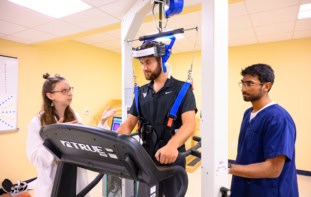
Positron emission tomography (PET) is an imaging technique used for early detection and management of cancer, as well as diagnosis of neurodegenerative diseases. While PET offers molecular sensitivity and quantitative accuracy, its spatial resolution is inferior to other medical imaging modalities; it also delivers ionizing dose to the patient.
To address these shortfalls, time-of-flight (TOF) technology is used to increase spatial precision, by detecting the time difference between the two 511 keV annihilation photons. Achieving a coincidence time resolution (CTR) of below 100 ps would provide major clinical benefits, enabling improved image quality, shorter acquisition times or reduced radioactive dose.
The ultimate goal for TOF-PET is a CTR of 10 ps, which corresponds to millimetre-level spatial resolution. Among many groups working towards this demanding target, a research team headed up at CERN is investigating the use of heterostructured scintillators to improve CTR, reporting the findings in Physics in Medicine & Biology.

“To get to a CTR of 100 ps (and towards 10 ps) while keeping good sensitivity and energy resolution, one of the main limits nowadays is the detector material. No known materials allow us to do this,” explains first author Fiammetta Pagano. “The concept of heterostructures is to combine two materials with complementary properties and take the best from both.”
An ideal TOF-PET heterostructure combines a high-Z scintillator with a high stopping power for 511 keV gamma rays, and a low-density material with ultrafast timing. Incoming gamma rays will most likely stop in the heavy material, but for a fraction of events – known as shared events – the photoelectron escapes from the high-Z material and deposits energy in the fast material. The more energy that these recoil photoelectrons deposit in the fast material, the more fast scintillation photons are produced, improving the overall timing resolution of the detector.
Optimizing the structure
To test this approach, Pagano and colleagues examined heterostructures formed from alternating layers of high-density bismuth germanate (BGO) and plastic scintillators. First, they performed Monte Carlo simulations to assess the response of various configurations to a 511 keV gamma-ray source.

The researchers simulated heterostructures formed from 100 µm-thick BGO layers (the thickness at which around half of the photoelectrons will likely escape from the BGO) and plastic scintillator plates with thicknesses from 10 to 220 µm. Comparison with simulations of bulk BGO revealed that as the plastic thickness increased from 10 to 220 µm, the probability of shared 511 keV events increased from 5% to 65%, while the sensitivity loss grew from 4% to 37%.
To find the optimal trade-off between sensitivity loss and gain in timing, the team evaluated the heterostructures against LYSO, the state-of-the-art TOF-PET detector. When both the plastic and BGO plates were 100 µm thick, the stopping power of the heterostructure was comparable to that of LYSO, almost half of the photoelectric events were shared and, for these shared events, about one third of the total energy was deposited in plastic.
Experimental measurements
Based on their simulations, the researchers chose two heterostructures for characterization: an optimal “100-100” configuration; and a “100-200” configuration, with 200 µm thick plastic plates. For each structure, they assembled a short pixel (3x3x3 mm) and a long pixel (3x3x15 mm), using the fast plastic scintillator EJ232.
They then measured the CTR of the four pixels, as well as a bulk BGO crystal and a layered BGO pixel, in coincidence with a reference crystal on the opposite side of a 22Na source. Moving from bulk to layered (stacked 100 μm-thick plates) BGO degraded the CTR from 271±14 ps to 303±15 ps, due to worse light transport in stratified structures. Introducing EJ232 into this structure, however, significantly improved the timing resolution compared with bulk BGO.
Considering all photopeak events, the 100-100 and 100-200 long pixels improved the CTR to 239±12 ps and 197±10 ps, respectively, demonstrating that the energy sharing mechanism can compensate for degradation introduced by stratification.
Considering only shared 511 keV events (depositing at least 50 keV in plastic), the 100-100 and 100-200 long pixels improved the CTR further, to 214±11 ps and 173±9 ps, respectively. The short pixels, meanwhile, achieved CTR values of 126±6 ps (100-100) and 114±6 ps (100-200). This improved CTR seen in the shorter heterostructures is expected due to the increasing importance of light transport effects with increasing pixel length.
Finally, the team performed depth-of-interaction (DOI) measurements for the long pixels, moving them vertically to irradiate five points along the DOI coordinate. This enabled quantification of light transport effects inside heterostructures, confirming that DOI blurring (arising due to the uncertainty of the interaction points of the 511 keV gamma ray in the pixel) is a key factor contributing to CTR degradation.

Why ultrafast detection is ultra-good
The researchers conclude that the heterostructures show potential for improving CTR while maintaining reasonable sensitivity. They note, however, that there is still some way to go before heterostructures become competitive with the state-of-the-art TOF-PET scintillators and are integrated into TOF-PET scanners.
“We are currently focusing on the implementation of a Geant4 code for simulating the transport of optical photons inside heterostructures, to understand how to improve the light transport and by consequence the CTR,” Pagano tells Physics World. “We are also going to assemble a matrix of heterostructure pixels in order to experimentally test a TOF-PET module made of heterostructures.”



